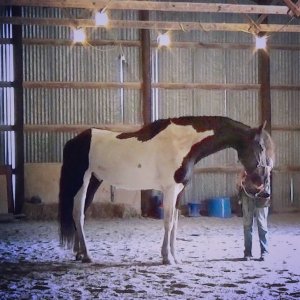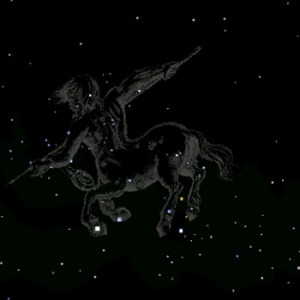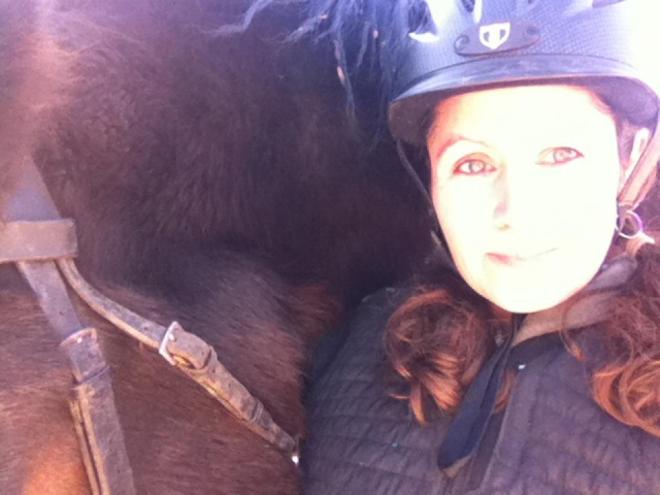Earlier this summer, I welcomed Hocus Pocus, a horse I had known many years ago, back into my life. He was on his way to becoming unsound so I immediately set out to change his unhealthy, habitual postures. (To learn more about this process, read my previous post, Shape-shifting Into Healthy Movement.)
His initial training, which spanned about three months, focused exclusively on teaching Hocus Pocus to carry himself in a new posture. The habitual way a horse organizes their body is a combination of their comformation, their emotional state and what they have been taught, intentionally or unintentionally, in their previous training. Maintained day after day, a horse’s habitual posture will incrementally change the horse over time, either strengthening and improving a horse’s longevity or causing long term imbalances that will result in tension, larger energy requirements in general, joint stress/damage and, often, a shorter lifespan. In Hocus Pocus’s case, his habitual posture was very unhealthy. He tended to move with his head up high, his brachiocephalic (underside) neck muscle braced, his back in tension and his pelvis disengaged out behind him. This posture reduced his range of motion, stressed his joints and made carrying himself, much less a rider, very difficult. I wanted Hocus to work toward his athletic potential, not away from it, so I set out to teach him a new coordination. I needed to teach him that lowering and extending his neck and letting his back relax would allow his hind end to step up and under toward his rib cage, making movement easier and allowing him to become stronger through his work. In addition, because he would be in a more powerful balance, he could begin to feel safe emotionally, rather than disconnected and vulnerable.
Initially, I taught Hocus this new posture in ground work. Ground work is when a human teaches the horse from the ground, often just in a halter and a lead rope. Ground work simplifies the process for the horse and reduces stress by keeping the lesson straightforward. It is a good starting place, but once the horse has mastered the lesson, it’s time to move on. (To read about the ground work process in detail, read my earlier post, “Shape-shifting into healthy movement”) From ground work, you can choose to move to longeing, in-hand work (work between two reins that educates the horse about how to use their body in relation to itself and in relation to a caveson or bridle), or ridden work. For Hocus, I chose the longe.
The longe provides a few different benefits:
1) Longeing offered me an opportunity to re-build Hocus Pocus’s longeing behavior in the positive reinforcement paradigm, confirming that he understood each aspect of longeing and was truly relaxed and active in the process.
2) I could allow Hocus to move out freely at a comfortable speed for him without me having to keep up. This builds fitness.
3) I could see Hocus’s entire body unlike working directly next to him in groundwork. (This is also called “seeing the panoramic”. It’s important to see fine details; it’s equally important to zoom out and be aware of the whole horse.)
4) Hocus could practice moving in relaxation for longer periods of time. This builds lovely emotional control for riding.
To appreciate the difference the ground work immediately created in Hocus’s posture on the longe, below is a photo of Hocus Pocus before he came to live here:

His neck is shortened, his hind end is out behind him rather than stepping toward his center of mass and his underline is the same length as his topline. He’s just slouching along; exercise in this posture will have no real benefit.
Below is a photo of Hocus Pocus on the longe after a few months of solid ground work:

This is a clickable moment! Here he is moving with a relaxed back and lengthened topline, which, in turn, allows him to have softer joints and a more expansive range of motion. His inside hind leg is stepping quite deeply for him up and under his rib cage which is the first touchstone on the road to collection. The entire picture gives the impression of roundness and elasticity. This is an “access posture”, meaning it’s not a long-term working posture, but an initial coordination where I can begin to influence Hocus’s hind foot flight arcs and general pelvic orientation. This is the posture where real conversations about balance and strength can begin.
This is the organization he chooses for his body now because of the solid reinforcement history we built over the last few months. He was clicked and fed for choosing this organization hundreds and hundreds of times. It’s a “default posture”, meaning, unless influenced otherwise, he chooses to move in this general shape.
So what does he look like in real time? Let’s take a look at Hocus Pocus in action on the longe line:
Watching the video, it’s easy to see that sometimes he drops his head too low and this makes him heavy on his front end and shoulders. He also still lacks any real power or engagement behind, but none of these things are anything to worry about at this stage of his training. All that matters right now is that he has the gross motor pattern of an open, lengthened spine and a relaxed back which allows his hind end to step up and under toward his rib cage. As he repeats this coordination in session after session, he will begin to step under more and more deeply and coil his loins to lift his back. Then, it will be easy for him to raise his head and neck; it will happen organically.
It’s also easy to see that longeing is being used to reinforce a specific skill, not just to blow off steam or to allow my horse to move in an over-stimulated or unhealthy way. Hocus has a clearly defined behavior to offer on the longe. This helps keep him focused on his own body rather than worrying about the environment.
Since I want to help Hocus Pocus become much stronger than he is currently, I also need to be able to work him in-hand. In-hand work, or work between two reins, differs from groundwork in that it connects to both sides of a horse’s body, so is more precise. Through in-hand work, I can teach Hocus to be straight, aligned, and healthy in his movement. In-hand work allows me to communicate more specifically to him about individual body parts through the reins. These connections through the reins are learned: as Bent Branderup says,” The response to the rein is a pedagogical process.” Many horses don’t receive a very detailed set of lessons regarding the reins, so they learn to shorten above or behind the reins which is natural, but not healthy. Teaching a horse to stretch down to a point of contact, which is described in countless books, in practice it is often not taught or well understood. Because Hocus Pocus had previously learned to shorten his neck and drop his back in response to rein contact, I needed to teach a new response in-hand. I wanted him to be able to stretch his neck out to reach for contact in my hand, the same posture we had confirmed on the longe. This is often described as “trusting the trainer’s hands”, which I suppose is true, but it is also a measurable behavior that I can click and reinforce. Here’s a photo of a particularly nice moment of Hocus stretching down to my point of contact in the walk in-hand:

Here’s a similarly lovely moment in the trot:

This is a beautiful starting point for our ridden work that will come later. Riding begins on the ground. From this biomechanically healthy place between two reins, I can start to teach stretching down into transitions and correct, balanced halts. These will help Hocus Pocus become more agile AND more confident about accepting suggestions from a human regarding his body. When we do begin riding for short periods, he will already know how to slow down and stop by stepping up and under with his hind feet, rather than slamming his weight onto his shoulders. It will just be one more cue transfer from in-hand to under saddle. Below is a short video of Hocus Pocus working in-hand, learning to stretch down into a downward transition, rather than shortening into disengagement.
You can see that he is largely able to stretch forward into the contact offered. When I ask him to walk by gently squeezing alternate reins, he has a few strides where he reverts to his old habit posture and raises his head and drops his back. That’s good information. He doesn’t get into trouble for this behavior, he’s not “wrong”, his old learning is just showing through. So we keep walking and I make contact with my outside rein and he is able to pick up that contact and stretch forward into it. A beautiful recovery and a clickable moment. Over time, he will regularly choose the new, lengthened posture over the old, stilted posture because of the reinforcement history, practice (repetition) and physical comfort it provides.
Before I can even consider sitting on Hocus’s back, I need to confirm that he can carry just his own body with strength and coordination. Adding weight, even with a small person like myself, makes maintaining these healthy postures much more difficult. Learning to carry weight is a gradual schooling process. Years and years ago, when Hocus Pocus was only three, I was the first person to “back” him, or sit on him just to introduce him to the idea that humans sit on horses (not to begin riding training, too early!). I remember that he dropped his back immediately and I decided he needed months more of work before I sat on him again. He was too weak. Now, I have a chance to re-start him, but with far more tools at my disposal than I had before. He is still the beautiful learner that he was, and now he is a mature horse coming eleven. With consistent work through this winter, he should be strong enough and educated enough to begin light riding in mid-spring.













